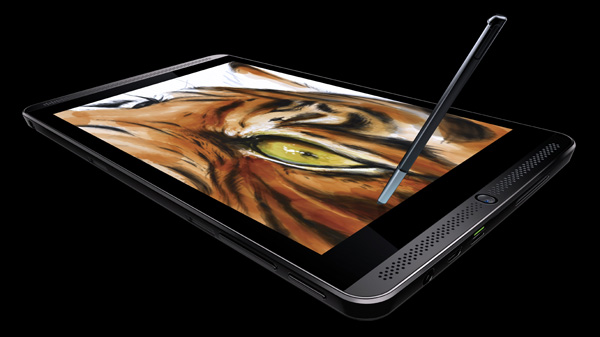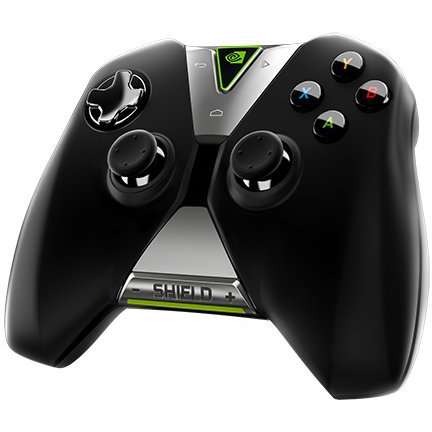Nvidia Officially Unveils the Shield Tablet and Shield Controller
The Shield Tablet advances both mobile media consumption and gaming by combining the best features of the Tegra Note 7 and Shield handheld gaming device into a compelling mini tablet and wireless controller.
Design and Features
The Shield Tablet comes with an 8-inch IPS screen with a resolution of 1920 x 1200 (283 PPI), which will support full HD video. Nvidia chose a one-size-fits-all design that seeks to balance usability and portability, unlike consumer products powerhouse Samsung, which seems to have as many tablet SKUs as Tegra K1 has CUDA cores. While there’s bound to be some disagreement over Nvidia’s choice of screen size, I think it’s a reasonable compromise. Using a larger screen erodes Nvidia’s “play games anywhere” philosophy, and would be redundant when using it in Console Mode hooked up to a big-screen TV. The 16:10 aspect ratio also works better for general tablet use, particularly in portrait mode, than the 16:9 form factor that has come to dominate desktop monitors.
The screen is flanked by pair of front-facing stereo speakers, a carry-over from the Tegra Note 7 and a feature I wish more tablets would incorporate. Sound is further enhanced by a pair of separate bass reflex ports.
There’s also a pair of cameras on the Shield Tablet. The rear camera has a 5 MP sensor with HDR and auto-focus. The front camera is also 5 MP with HDR, but is fixed focus.
The overall design of the Shield Tablet draws heavily from the Tegra Note 7, looking nearly identical from the front. Constructed from plastic, it has a nicely understated, all matte black appearance. Ditching the stippled back of the Tegra Note 7, the new tablet adopts a simpler look similar to the Nexus 7, but with a slightly recessed, gloss black “SHIELD” branding.
The power button is located on the top, right side when held in portrait mode, with the volume rocker directly below. There’s also a covered microSD slot situated below the volume rocker. The bottom, right corner has a port for securely storing the stylus.
All of the remaining ports reside along the top edge, including microUSB 2.0, MiniHDMI 1.4a, and a headphone jack.
Wireless connectivity includes 802.11a/b/g/n (2x2 MIMO) Wi-Fi and Bluetooth 4.0 LE. It would be nice to see 802.11ac support, but apparently Nvidia feels it can get enough bandwidth via 802.11n.
Get Tom's Hardware's best news and in-depth reviews, straight to your inbox.
The LTE version of the Shield Tablet uses Nvidia’s Icera i500 Soft Modem, which includes eight programmable cores running up to 1.3GHz. These specialized DSP cores are paired with a separate RF transceiver chip. Icera supports GSM/GPRS/EDGE, HSPA+ (42 Mbps), and LTE Category 3 (100 Mbps). Since the modem is handled in software, it can be upgraded to support additional standards. Nvidia’s documentation states that the Icera i500 is capable of supporting LTE Category 4 (150 Mbps) with Carrier Aggregation and HSPA+ (84 Mbps), although it’s unclear if the Shield Tablet supports the faster speeds.
Current page: Design and Features
Prev Page The Nvidia Shield Tablet And Controller Create A Compelling Package Next Page Software and Stylus-
TechyInAZ Cool! What a great tablet for not just gaming, but it can also be a great productivity powerhouse.Reply -
DarkSable ... seriously Tom's?Reply
Websites have been proclaiming the end of the world as we know it (or at least of desktop computers) for years now, and it's all just built on itself. The reason desktop sales have declined marginally is because most home users already have a desktop fast enough for their needs, and only need to replace it when it breaks.
The other reason is that people have leapt headfirst into the pile of hype that surrounds tablets, which means they're going to see great growth... right until they hit market saturation. -
InvalidError Reply
Tablet sales have already started to slow down; probably in large part due to tablet specs having remained mostly stagnant for much of the past two years. I hoped the N7-2013 would start a flood of decent ~$200 devices but it seems most of the sub-$300 segment just continued filling up with devices having specs closer to the N7-2012 instead.13776476 said:The other reason is that people have leapt headfirst into the pile of hype that surrounds tablets, which means they're going to see great growth... right until they hit market saturation.
PCs on the other hand are getting bumper sales on the back of companies being forced off XP. -
hahmed330 I have to correct one thing Matt... You can use Nvidia Grid Streaming from anywhere, but obviously you need latency of less then 40ms and 10mbit download speed for a great experience. I am seriously looking forward for the whole review though. Direct Stylus 2 looks really interesting. Hopefully Remote Gamestream has come out of beta.Reply -
TheMentalist People always open their mouth saying the shield is worthless. It's the best hardware you get for the money!Reply -
DarkSable Guys, read what I was saying.Reply
Never did I say that the Shield, or the shield tablet, was worthless - I think they're great pieces of tech.
I was annoyed with Tom's Hardware for perpetuating the absolutely faulty myth, which has been around for at least five years now, that desktop computers are "on their way out" and that we should all give up and buy mobile devices.
I have a 3ds and a nexus 5, both of which I like to game on... but that doesn't mean I'm giving up my gaming computer, or that gaming computers aren't going to exist in a few years. -
kamhagh That Price is amazing!!!! Also i agree with darkdable,,Reply
Phones will NEVER replace pc, well at least not for next 80 years! And touch is the worst kind of input, specially for gaming, but its portable and good! Ita good to play awesome games outside and bring it with you, but still, its not pc!!! Pc is amazing, mouse and keyboard, huge screen, -
InvalidError Reply
Well, Intel is putting more effort in their laptop/mobile/embedded R&D and still pushing power-efficiency across the board, Nvidia adopted a mobile-first design mentality, AMD is moving to a heavily if not exclusively APU-centric device lineup, etc.13777299 said:I was annoyed with Tom's Hardware for perpetuating the absolutely faulty myth, which has been around for at least five years now, that desktop computers are "on their way out" and that we should all give up and buy mobile devices.
They might not be dropping desktops overnight but they are all moving in the same general direction: towards a future of mostly low-power if not mobile/embedded systems.
XP maintaining a ~30% market share until Microsoft dropped public support for it is living proof that many people and applications do not need anywhere near as much processing power as today's entry-level systems provide. Intel's Q2 report says ASPs have dropped by 3%, meaning that a fair chunk of Intel's end-of-XP bumper sales are for lower-end/lower-cost chips. This is not going to get better. -
airborne11b I love this new design. It's a mobile gaming powerhouse and if you combine it with a controller that attaches to the device itself, you get one hell of a mobile gaming device with a huge screen that also doubles as a really powerful android tablet.Reply
PC streaming, GRID, Console Mode, Tegra K1 fueled android gaming, Direct2 Stylus, full android OS backed by serious processing power.
All for $299. I can't wait to get my hands on it.
I also sent an email asking when the STG-ONE tablet-attachable controller will be released. I'll reply back here if I get a response.




